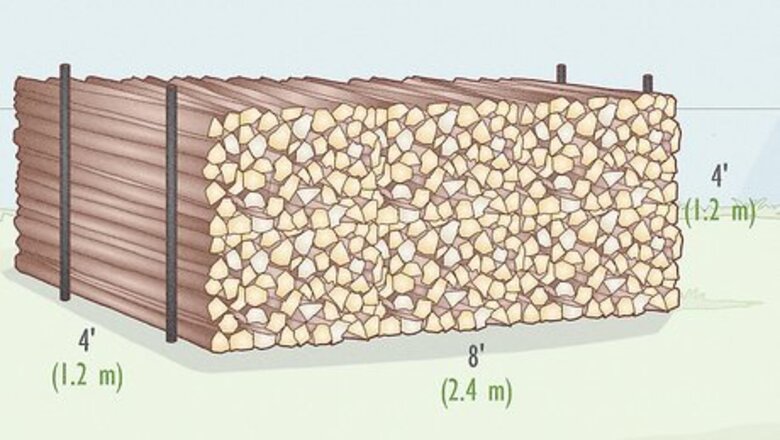
views
Understanding the Terminology
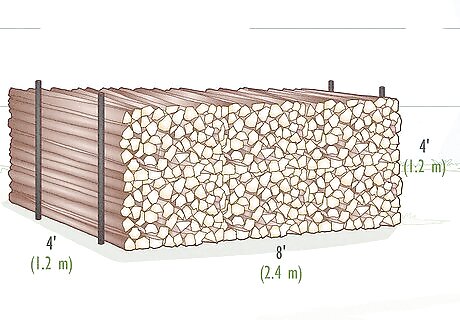
Know the dimensions and volume of a full cord. A full cord, also referred to as a "cord," is a stack of wood that measures 4 feet (1.2 m) wide, 4 feet (1.2 m) tall, and 8 feet (2.4 m) long. Its total volume should be 128 cubic feet (3.5 cubic meters). Note that the exact amount of solid wood in a cord will vary based on the size of each piece, but most cords of firewood average 85 cubic feet (2.4 cubic meters) of solid wood. The remaining volume is taken up by air. The entire length of the pile should be 8 feet (2.4 m), but the length of each piece of wood matches the width or depth of the pile and should average about 4 feet (1.2 m). Even though the cord is the standard unit of measurement when selling wood, most firewood dealers do not sell 4-ft (1.2-m) long pieces of wood to home consumers. As a result, other cord-based terminology is often introduced.

Compare the full cord to the face cord. A face cord is the next most common unit of measurement. It refers to any stack of wood that is 4 feet (1.2 m) high and 8 feet (2.4 m) long. The depth or width of the pile is less than 4 feet (1.2 m), which means that each piece of wood in the pile is less than 4 feet (1.2 m) long. There is no single agreed upon length for pieces of wood in a face cord. On average, the length of most firewood is 16 inches (40.6 cm), so the depth of most face piles is 16 inches (40.6 cm). This is one-third the depth of a full cord. Other piece lengths can also be used, however, so you'll need to make sure that you find out how long the average piece in a face cord is before you make the purchase. While "face cord" is the most common terminology used to describe piles like this, "stove cord,” "furnace cord," “run,” and “rick” are also used and refer to the same thing.
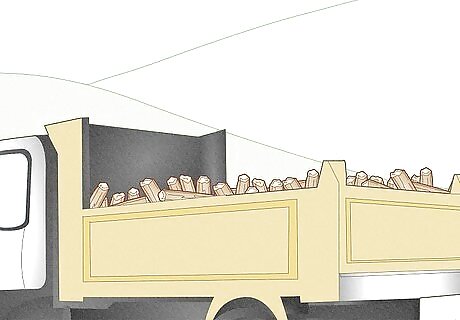
Familiarize yourself with the thrown cord. A thrown cord or loose thrown cord is a rough measurement of volume on wood that has been tossed or dumped into a truck, rather than stacked into neat, compact piles. A loose thrown cord should take up about 180 cubic feet (6.66 cubic yards or 5.1 cubic meters) of space as is. The idea is that, when stacked, the total volume would equal roughly 128 cubic feet (3.5 cubic meters), or the volume of a full cord. A "thrown" cord takes approximately 30%+- more space than a stacked cord. A typical pickup truck w/ 6ft. bed is 54 cubic feet (2 cubic yards - level load-Stacked); an 8ft. bed is 81 cubic feet (3 cubic yards - heaped load- Stacked). Remembering now! that "thrown" takes 30%+- more (space) than stacked. Therefore a 6ft. truckload has 30%+- of a "thrown" cord; an 8ft. truckload has 45%+- of a "thrown" cord. This usually applies to wood pieces between 12 and 16 inches (30.5 and 40.6 cm) long. When wood pieces are sold in lengths of 2 feet (60.1 cm), total thrown cord volume should be about 195 cubic feet (5.5 cubic meters).

Learn about green cords. A green cord refers to a measurement that was taken before wood was split and dried. As such, the current or dried volume can be smaller than the indicated volume by 8 cubic feet (0.23 cubic meters). The green cord volume should be 180 cubic feet (5.1 cubic meters) if loosely stacked or 128 cubic feet (3.5 cubic meters) if neatly stacked, just as you would expect of a loose cord or full cord, respectively. When green, unseasoned wood is dried, the wood shrinks by about 6 to 8 percent. Firewood dealers sometimes measure and price their merchandise by the green cord instead of full cords or loose cords as a way to make up for the money they would otherwise lose from the shrinkage of wood.
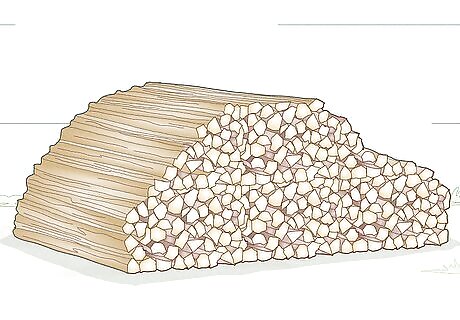
Watch out for measurements that cannot be compared to full cords. Sometimes, a dealer might try to sell wood by rough measurements like truckloads, piles, station wagon loads, or pick-up truck loads. Measurements like these are not regulated and can be difficult to compare, so you might end up getting far less wood than what you paid for if you trust them. Some states within the United States even ban the sale of firewood by measurements not based on the full cord.
Measuring Cords
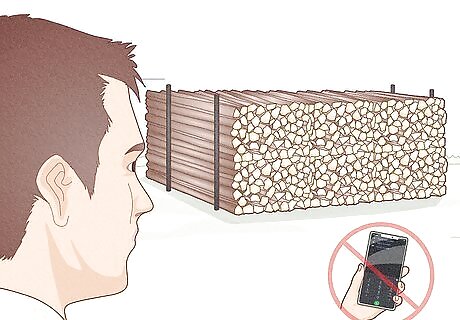
Look before you buy. If possible, avoid buying wood by telephone or online. Visit the supplier yard yourself and take your own measurements. Measuring from the stacks of wood you plan on purchasing is the safest way to know exactly what you are getting. If you cannot measure the wood yourself or see the wood before you buy it, at least go through a known dealer with a positive reputation. After you receive the wood, take your own measurements to make sure that you were not cheated.

Verify the length and height of the pile. Take a tape measure or yardstick and measure the height and length of the entire pile. For both full cords and face cords, the length should be 8 feet (2.4 m) and the height should be 4 feet (1.2 m). The exact length and height can vary when you purchase a thrown cord, but you should still measure these dimensions and check them against the dimensions listed by the dealer.
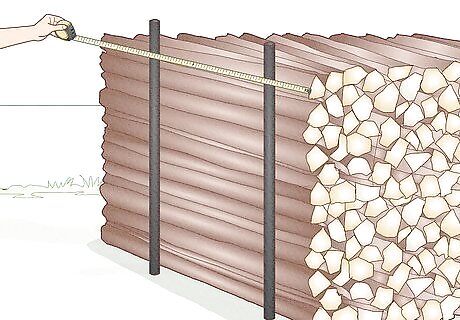
Measure the depth of firewood pile. Take your tape measure or yardstick and measure the depth of the pile, or the average length of each piece of firewood in that pile. Measure the average log length, not the length of the longest piece or the shortest piece. For full cords, the length must be 4 feet (1.2 m). For thrown cords, the length must bring the overall volume of the stack to 180 cubic feet (5.1 cubic meters) when multiplied by the measured height and length of the pile. If you are purchasing a face cord, keep this measurement on hand so that you can use it to calculate the full cord value.
Determining Value
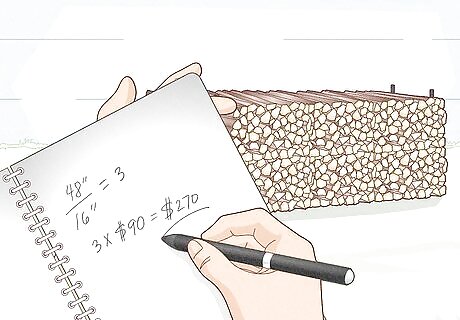
Calculate the full cord value. If you are buying a face cord, divide the depth of a full cord by the piece length of the wood in your face cord. Multiply this quotient by the price of your face cord to determine the cost of the full cord. Remember that the depth of a full cord is 4 feet (1.2 m) or 48 inches (1.2 m or 122 cm). For instance, if Bob is selling a face cord with an average piece length of 16 inches (40.6 cm) for $90, the calculation would look something like this: 48 inches (122 cm) / 16 inches (40.6 cm) = 3 3 * $90 = $270 The full cord value would be $270.

Shop around. If you know the average market rate of a full cord in your area, you can compare the full cord value of the face cord you measured to that. If you do not know the average cost, however, you might need to shop around some and figure out your own average. It might save time to call each dealer and ask for their face cord price and piece length measurement, rather than going to each one and taking your own measurements. You should still measure the average piece length of the face cord you plan to buy once you've made your decision, though, just to make sure that the dealer's measurements match your own.
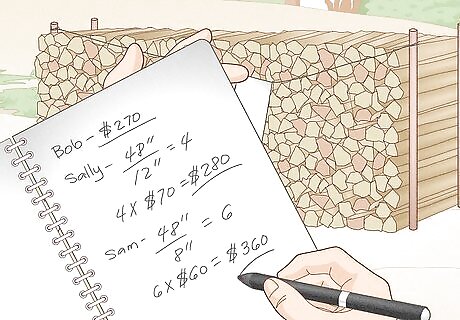
Compare the value offered by each seller. If the piece length offered by each dealer is the same, you can compare face cord costs. If the piece lengths vary, however, you need to calculate the full cord value of each and compare those values to one another. In the previous example, Bob sold firewood at a full cord value of $270. If Sally sold 12-inch (30.5-cm) long pieces of firewood at $70, the full cord value would be: 48 inches (122 cm) / 12 inches (30.5 cm) = 4 4 * $70 = $280. If Sam sells 8-inch (20-cm) long pieces of wood at $60, the full cord value would be: 48 inches (122 cm) / 8 inches (20 cm) = 6 6 * 60 = $360 Even though Bob has the highest face cord price, he has the lowest full cord value at $270. Sally's full cord value is close at $280, but Sam's full cord value is by far the most expensive at $360, even though Sam's face cord cost was cheapest ($60). As such, the best value for your money would be Bob's face cord.

Be aware of outside factors that can affect cost. Even though full cord value is the best way to get the best deal, there are other factors to consider that usually increase the value and cost of wood. Shorter lengths usually cost more because of the cost of cutting and handling. Firewood cut into consistent lengths may cost more because more work went into maintaining that even length. Finely split pieces usually cost more because of the extra labor, as well. Dry wood can cost more because it has been stored under better conditions. Cleaner firewood is also more valuable because it is more pleasant to the consumer when it comes time to burn it.



















Comments
0 comment